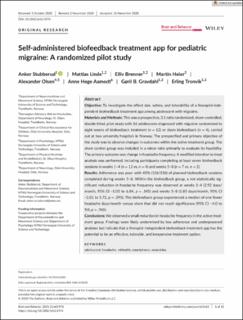| dc.contributor.author | Stubberud, Anker | |
| dc.contributor.author | Linde, Mattias | |
| dc.contributor.author | Brenner, Eiliv | |
| dc.contributor.author | Heier, Martin | |
| dc.contributor.author | Olsen, Alexander | |
| dc.contributor.author | Aamodt, Anne Hege | |
| dc.contributor.author | Gravdahl, Gøril Bruvik | |
| dc.contributor.author | Tronvik, Erling Andreas | |
| dc.date.accessioned | 2021-04-26T12:34:51Z | |
| dc.date.available | 2021-04-26T12:34:51Z | |
| dc.date.created | 2020-12-20T13:46:21Z | |
| dc.date.issued | 2020 | |
| dc.identifier.citation | Brain and Behavior. 2021, 11 (2), 1-11. | en_US |
| dc.identifier.issn | 2162-3279 | |
| dc.identifier.uri | https://hdl.handle.net/11250/2739641 | |
| dc.description.abstract | Objective
To investigate the effect size, safety, and tolerability of a therapist‐independent biofeedback treatment app among adolescent with migraine.
Materials and Methods
This was a prospective, 3:1 ratio randomized, sham‐controlled, double‐blind, pilot study with 16 adolescents diagnosed with migraine randomized to eight weeks of biofeedback treatment (n = 12) or sham biofeedback (n = 4), carried out at two university hospitals in Norway. The prespecified and primary objective of the study was to observe changes in outcomes within the active treatment group. The sham control group was included in a minor ratio primarily to evaluate its feasibility. The primary outcome was change in headache frequency. A modified intention to treat analysis was performed, including participants completing at least seven biofeedback sessions in weeks 1–4 (n = 12 vs. n = 4) and weeks 5–8 (n = 7 vs. n = 2).
Results
Adherence was poor with 40% (136/336) of planned biofeedback sessions completed during weeks 5–8. Within the biofeedback group, a not statistically significant reduction in headache frequency was observed at weeks 1–4 (2.92 days/month, 95% CI −1.00 to 6.84, p = .145) and weeks 5–8 (1.85 days/month, 95% CI −2.01 to 5.72, p = .395). The biofeedback group experienced a median of one fewer headache days/month versus sham that did not reach significance (95% CI −4.0 to 9.0, p = .760).
Conclusions
We observed a small reduction in headache frequency in the active treatment group. Findings were likely undermined by low adherence and underpowered analyses but indicate that a therapist‐independent biofeedback treatment app has the potential to be an effective, tolerable, and inexpensive treatment option. | en_US |
| dc.language.iso | eng | en_US |
| dc.publisher | Wiley Periodicals LLC | en_US |
| dc.rights | Navngivelse 4.0 Internasjonal | * |
| dc.rights.uri | http://creativecommons.org/licenses/by/4.0/deed.no | * |
| dc.title | Self-administered biofeedback treatment app for pediatric migraine: A randomized pilot study | en_US |
| dc.type | Peer reviewed | en_US |
| dc.type | Journal article | en_US |
| dc.description.version | publishedVersion | en_US |
| dc.source.pagenumber | 1-11 | en_US |
| dc.source.volume | 11 | en_US |
| dc.source.journal | Brain and Behavior | en_US |
| dc.source.issue | 2 | en_US |
| dc.identifier.doi | 10.1002/brb3.1974 | |
| dc.identifier.cristin | 1861992 | |
| dc.description.localcode | This is an open access article under the terms of the Creative Commons Attribution License, which permits use, distribution and reproduction in any medium, provided the original work is properly cited. | en_US |
| dc.source.articlenumber | e01974 | en_US |
| cristin.ispublished | true | |
| cristin.fulltext | original | |
| cristin.qualitycode | 1 | |

